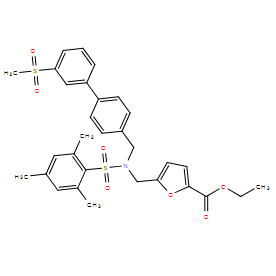| Cas No.: | 1416153-62-2 |
| Chemical Name: | Ethyl 5-[[[[3'-(Methylsulfonyl)[1,1'-biphenyl]-4-yl]methyl][(2,4,6-trimethylphenyl)sulfonyl]amino]methyl]-2-furancarboxylate |
| Synonyms: | SR9238,SR-9238,SR 9238 |
| SMILES: | CCOC(C1=CC=C(O1)CN(S(=O)(C2=C(C=C(C=C2C)C)C)=O)CC3=CC=C(C4=CC(S(C)(=O)=O)=CC=C4)C=C3)=O |
| Formula: | C31H33NO7S2 |
| M.Wt: | 595.73 |
| Purity: | >98% |
| Sotrage: | 2 years -20°C Powder, 2 weeks 4°C in DMSO, 6 months -80°C in DMSO |
| Description: | SR9238 is a synthetic LXR antagonist with IC50s of 214 nM and 43 nM for LXRα and LXRβ, respectively. |
| Target: | IC50: 43 nM (LXRβ), 214 nM (LXRα)[1] |
| In Vivo: | Approximately 6 μM SR9238 is detected in the liver 2h after the injection of SR9238, but no compound is detected in the plasma. SR9238 is also detected in the intestine with either ip or oral administration. SR9238-treated mice display greatly reduced lipid content in the liver. Results demonstrate that both Tnfa and Il1b expression are substantially reduced (~80% and >95%, respectively) in the SR9238-treated mice when compare to the vehicle-treated mice. SR9238-treated DIO mice display considerably lower intensity of F4/80 staining versus vehicle-treated DIO mice consistent with a beneficial effect of SR9238 on non-alcoholic steatohepatitis (NASH). SR9238 treatment does not alter body weight or percent body fat composition relative to vehicle treated animals during the experiment. Treatment with SR9238 suppresses diet-induced hepatosteatosis, hepatic inflammation, and hepatocellular injury[1]. |
| In Vitro: | Results from the cell-based cotransfection assays demonstrate that SR9238 is a synthetic LXR inverse agonist with IC50s of 214 nM and 43 nM for LXRα and LXRβ, respectively. SR9238 also effectively suppresses transcription from a fatty acid synthase (Fasn) promoter driven luciferase reporter. It is found that SR9238 induces increased interaction of CoRNR box peptides derived from NCoR (NCoR ID1 and NCoR ID2) with both LXRα and LXRβ, while causing decreased interaction with a coactivator NR box peptide derived from TRAP220. SR9238-induced recruitment of CoRNR box peptides is dose-dependent for both LXRα and LXRβ. HepG2 cells treated with SR9238 result in a significant decrease in Fasn and Srebp1c mRNA expression[1]. |
| Cell Assay: | HepG2 cells are seeded at 5×105 cells/mL in a 4-chamber culture slide. The following day the media is removed and replaced with antibiotic-free media containing 10 μM of DMSO or SR9238 and cells are allowed to grow for 48 h. Cells are washed in TBS, fixed and fluorescently stained for SREBP2 according to the assay protocol[1]. |
| Animal Administration: | Twenty-one-week-old male C57BL6 DIO mice are used. Animals are individually housed and fed a high fat diet (60% kcal/fat diet, 20% carbohydrate) for the duration of the experiment that includes SR9238 administration for 30 days (30 mg/kg, qd, ip). Prior to initiation of the experiment, animals are provided the high fat diet for 10-weeks. Animals are acclimated to the environment for one week and sham dosed with vehicle for 3 days prior to SR9238 administration. Body weight and food intake are monitored daily. Pre- and post-experiment body composition analysis is performed on all the mice. Blood is collected by cardiac puncture and used for plasma cholesterol and triglyceride measurements. Livers are weighed and immediately flash-frozen in liquid nitrogen for gene expression analysis or put in formalin on ice for histology[1]. |
| References: | [1]. Griffett K, et al. A liver-selective LXR inverse agonist that suppresses hepatic steatosis. ACS Chem Biol. 2013 Mar 15;8(3):559-67. |

 DC Chemicals' products qualify for U.S. tariff exemptions. We guarantee no price increases due to customs duties and maintain stable supply, continuing to deliver reliable research solutions to our American clients.
DC Chemicals' products qualify for U.S. tariff exemptions. We guarantee no price increases due to customs duties and maintain stable supply, continuing to deliver reliable research solutions to our American clients.





















